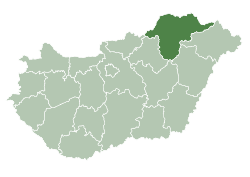Felsőzsolca
| Felsőzsolca | ||
|---|---|---|
| ||
 Felsőzsolca Location of Felsőzsolca | ||
| Coordinates: 48°06′31″N 20°51′20″E / 48.10872°N 20.85557°ECoordinates: 48°06′31″N 20°51′20″E / 48.10872°N 20.85557°E | ||
| Country |
| |
| County | Borsod-Abaúj-Zemplén | |
| Area | ||
| • Total | 16.24 km2 (6.27 sq mi) | |
| Population (2001) | ||
| • Total | 7,120 | |
| • Density | 440.27/km2 (1,140.3/sq mi) | |
| Time zone | CET (UTC+1) | |
| • Summer (DST) | CEST (UTC+2) | |
| Postal code | 3561 | |
| Area code(s) | 46 | |
Felsőzsolca is a small town in Borsod-Abaúj-Zemplén county, Northern Hungary, in the Miskolc agglomeration. It is the city with the tenth highest population in Borsod-Abaúj-Zemplén county and the second biggest in the Miskolc agglomeration.
Location
Felsőzsolca is situated next to Miskolc, 1 km (1 mi) from the outskirts of Miskolc (the centres of the two cities are about 6 km (4 mi) from each other). The town is situated at the eastern tip of the Bükk Mountain, on the left bank of the river Sajó, and in the Borsod region bordered by the eastern side of Abaúj. The topography is flat, mildly hilly, its rock is composed of
loess (?) material.
Transport
It is accessible by roads 3 and 37, by train on the Budapest-Miskolc-Sátoraljaújhely line, and on the Miskolc-Hidasnémeti line. The railway station is 3 km (2 mi) from the town.
Public transit for Felsőzsolca is provided by the neighboring Transport Company of Miskolc, (MVK Zrt.) Now, one bus service, line 7, serves the citizens. Besides this, several coach services travel through the town on Szent István street, and on Kassai street.
Geographical connections
- Northeast: valley of river Hernád, Szikszó
- North: hills of Cserehát
- Northwest: Sajószentpéter, Kazincbarcika, Edelény towns
- West: Bükk Mountain, Miskolc centre of the county
- South: valley of river Sajó, Tisza, Tiszaújváros, Polgár, Debrecen towns
- East: underneath of Tokaj Mountain, Taktaköz, Szerencs, Tokaj towns
Climate
Complexion: continental temperature, min-max.: -25 °C till +35 °C, annual average temperature is 11 °C
Hydrogeology
Next to the town, on the western side is the river Sajó and its tributary stream, Little-Bódva (Little-Sajó as others call it). There was a lake, called Pond Priest, between Miskolc and Felsőzsolca that has a legend associated with it. According to the legend, a church had sunk into the pond. The pond was pumped out in 2008, and the area has been built on. In June, 2010 an historic flood hit Felsőzsolca. Out of a total of 2200, about 1800 houses were damaged, and over 200 houses collapsed. The restoration is in progress now.
History
The area has been inhabited since Neolithic times. The town was first mentioned in 1281 in a document about territory disputed between Zsolca and Miskolc. The document states that the border of the two towns will always be the river Sajó.
In the Middle Ages Zsolca was a prospering village, but the Turks destroyed it. The village suffered a lot during the revolution against the Habsburgs in 1848–49, and when the Russians (allies of the Habsburgs) burned it down. In 1867 a monument was built commemorating the Battle of Zsolca. This made the village the second place in the country where a monument for the revolution was erected.
During the 20th century the county became an important industrial area, and the population of Felsőzsolca grew, mainly because of its proximity to Miskolc. By 1980 it had more than 7000 residents. In 1997 it was granted town status.
Unlike many villages, Felsőzsolca managed to avoid being annexed to Miskolc, mostly because of the Sajó, which acts as a natural border between them, and the town exists in symbiosis with the city. Felsőzsolca is the only town that is connected to Miskolc by the bus lines of MVK Zrt., the city's mass transport company even though it is officially an independent town.
Ethnical groups
91% of the population has Hungarian nationality, and 9% of the inhabitants has Roma nationality. Out of this, Bulgarian and Polish minority also live in Felsőzsolca.
Sights
- Anglican Church, built in 1851.
- Roman Catholic Church. It was built in 1900 to honour Keresztelő Szent János.
- Castle of the Bárczay family, restored in 2001.
- Museum and library within the castle.
- Monument of the Trianon. Garlands are placed every year to commemorate June 4, 1920.
- Wind-power station near Felsőzsolca that was built in 2006 and is called Cervantes.
- A motor-cross field existed between Miskolc and Felsőzsolca, that was destroyed in 2008. The site now has been taken over to construction.
- Felsőzsolca Városi Sportcsarnok
Twin towns
 Királyhelmec, Slovakia
Királyhelmec, Slovakia Nyikómalomfalva, Romania
Nyikómalomfalva, Romania Visk, Ukraine
Visk, Ukraine Olsztynek, Poland
Olsztynek, Poland Magyarkanizsa, Serbia
Magyarkanizsa, Serbia Izmir, Turkey
Izmir, Turkey Draganovo, Bulgaria
Draganovo, Bulgaria
External links
| Wikimedia Commons has media related to Felsőzsolca. |


